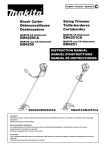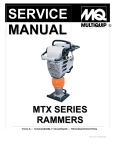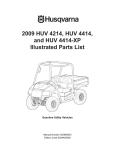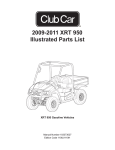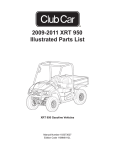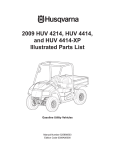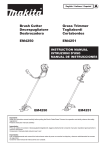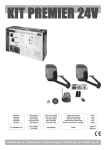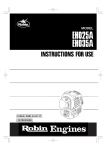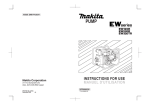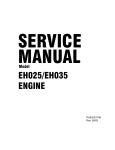Download Makita EM4251 Service manual
Transcript
OHV Petrol Engine Service Manual Model: EM4250, EM4251 CONTENTS - 1/2 Section Title 1 2 2 2 2 2 - 1 2 3 4 3 3 - 1 3 - 2 4 4 4 4 4 4 - 1 2 3 4 5 4 4 4 4 4 4 4 - 6 7 8 9 10 11 12 Page SPECIFICATIONS OF ENGINE PERFORMANCE Maximum Output Continuous Rated Output Maximum Torque and Fuel Consumption with Maximum Output Performance Curves FEATURES The smallest and Lightest 4-Stroke Engine in the Trade 4-Stroke Engine allowing Operation in the Tilted Position, that is required in Lawn Mowing Work and other similar Applications 1 2 2 2 2 3 4 4 GENERAL DESCRIPTION OF ENGINE COMPONENTS Cylinder and Crankcase Crankshaft and Connecting Rod Piston Piston Rings Cam Gear 7 7 7 7 8 8 4 Cooling System Lubrication System Ignition System Carburetor Air Cleaner Decompression System Sectional View of Engine DISASSEMBLING AND REASSEMBLING 8 8 9 9 9 9 10 12 Preparations and Suggestions Procedures for Disassembling Procedures for Reassembling 12 12 22 7 - 1 7 - 2 MAGNETO Operation and Function Basic Theory AUTOMATIC DECOMPRESSION SYSTEM Function and Constructions Inspection 8 - 1 8 - 2 CARBURETOR Operation and Construction Disassembling and Reassembling 35 35 35 36 36 36 37 37 38 9 9 9 9 RECOIL STARTER How to Disassemble How to Reassemble Check after Reassembling Other Guides 40 40 41 42 42 5 5 - 1 5 - 2 5 - 3 6 6 - 1 6 - 2 7 8 9 - 1 1 3 3 CONTENTS - 2/2 Section Title 10 10 10 10 10 10 10 - 1 2 3 4 5 6 11 11 11 11 - 1 2 3 4 11 TROUBLESHOOTING Starting Difficulties Engine Misfire Engine Stops Engine Overheat Engine Knocks Engine backfires Through Carburetor INSTALLATION Installing Ventilation Exhaust Gas Discharge Power Transmission to Driven Machines Page 43 43 43 44 44 44 44 44 44 45 45 45 P 1 / 45 1. SPECIFICATIONS OF ENGINE EH025 Model No. Air-Cooled, 4-Cycle, Single-Cylinder, Type Horizontal P.T.O. Shaft, OHV Gasoline Engine Bore x Stroke 34 mm x 27 mm (1.5/16" x 1-1/16") Piston Displacement 24.5 cm3 (1.5 cu.in.) Compression Ratio 8.5 Continuous 0.55kW (0.75HP) / 7,000 r.p.m. Max. 0.81kW (1.1HP) / 7,000 r.p.m. Output Max. Torque Direction of Rotation 1.18N.m (0.12kgf.m) / 5,000 r.p.m. Counterclockwise As Viewed From P.T.O. Shaft Side Cooling System Forced Air Cooling Valve Arrangement Overhead Valve Lubrication Splash Type Lubricant Capacity of Lubricant Automobile Oil SAE #20, #30 or 10W-30 ; Class SF or higher 0.08 liters (0.02 US.gal.) Carburetor Fuel Fuel Consumption Ratio Diaphragm Type Automobile Unleaded Gasoline 408g/kW.h (300g/HP.h) At Continuous rated output Fuel Feed System Fuel Tank Capacity Gravity Type 0.5 liters (0.13 US.gal.) Ignition System Flywheel magneto (Solid State) CMR6A Spark Plug Starting System Recoil Starter Air Cleaner Semi-Wet Type Dry Weight 2.8 kg (1.27 lbs.) Dimensions (L x W x H) 165mm x 213mm x 225mm (6-1/2 " x 8-3/8" x 8-7/8") Specifications are subject to change without notice. P 2 / 45 2. PERFORMANCE 2 - 1 Maximum Output The maximum output is the output of an engine with its throttle valve fully opened under the condition that all the moving parts are properly broken in after the initial break-in period. A new engine may not produce full maximum output while its moving parts are still not broken-in. 2 - 2 Continuous Rated Output The continuous rated output is the output of an engine at optimum controlled speed which is most favorable from the view point of engine's life and fuel consumption. The concept of the engine is that it can be operated also with the smaller output than the continuous rated output, when the engine is installed on a certain equipment. 2 - 3 Maximum Torque and Fuel Consumption with Maximum Output The maximum torque, which does not have the proportional relation with the maximum output, is the output produced at the shaft, The fuel consumption rate is the amount of fuel in grams consumed per horsepower-hour when the engine is working with continuous rated output. P 3 / 45 2 - 4 Performance Curves (PS) (kW) 1.0 1.2 1.0 0.10 0.8 0.08 0.6 0.06 Torque (N.m) (kg-m) 1.2 0.12 MAXIMUM TORQUE MAXIMUM HORSEPOWER 0.8 1.0 0.6 0.6 0.4 RECOMMENDABLE HORSEPOWER RANGE 0.4 0.2 (g/kWh) (g/PSh) 600 450 400 500 350 0.2 0 0 FUEL CONSUMPTION 400 300 250 300 4,000 5,000 Revolution 6,000 Fuel Consumption Rate OUTPUT 0.8 CONTINUOUS RATED HORSEPOWER 7,000 (r.p.m.) 8,000 P 4 / 45 3. FEATURES 3 - 1 The Smallest and Lightest 4-Stroke Engine in the Trade 1) Small-sized lubricant oil tank. thanks to the lubrication system developed by MAKITA. 2) Compact construction realized thanks to the optimum design, not taking into consideration any increase in the cylinder bore. 3) Shorter shaft at the output side (magneto side), by arranging the cam gear unit at the opposite side of the magneto. 4) Light weight construction, thanks to the cam gear, rocker arm cover and other parts made of synthetic resin. 5) Parts of the valve driving system with thoroughgoing light weight construction. 3 - 2 4-Stroke Engine allowing Operation in the Tilted Position, that is required in Lawn Mowing Work and other similar Applications 1) MAKITA's original lubricating system Small-sized lubrication system with high reliability, that makes it possible operate the engine in tilted position during the execution of practical work. Basic system description Oil flow Blow-by air (including fresh air) and oil mist Fig 3-1 P 5 / 45 (a) Since the lubricating system operates by making use of the pressure fluctuations in the crankcase, a lead valve is arranged at the lower part of the crankcase. Using the negative pressure that occurs during the piston ring stroke, lubricant oil is supplied by the oil tube (located inside the oil tank, that is arranged separated from the crankcase) to the crankshaft located in the crankcase, with the lubricant oil passing via rotary valve that opens and shuts with an appropriate timing. (b) At the same time, fresh air and blow-by air containing oil mist coming from the rocker arm compartment are sucked through the two assist holes that open at the vicinity of the upper dead center of the piston. (c) The supplied oil is diffused by the crank arm and other parts of the engine, thereby transforming in mist. That diffused oil mist is compressed during the piston lowering stroke, and an appropriate quantity of that compressed oil mist is pumped via interconnecting path by the lead valve, located at the lower part of the crankcase, to the cam gear compartment and to the rocker arm compartment. Thus, it lubricates the various parts of the engine. The remaining portion of the oil mist in excess returns to the oil tank via bypass hole. (d) The oil tank is provided with two pressure relief holes that are located at its left and right sides and are interconnected with the assist holes of the cylinder unit. These pressure relief holes have the function of keeping the inner pressure of the oil tank at an approximately constant value. (e) Oil located inside the rocker arm compartment is sucked back to the crankcase by the strong negative pressure that occurs inside the crankcase, passing through the two return paths that are located at the left and right sides. (f) The mixture consisting of the blow-by gas and a small amount of oil mist goes from the rocker arm compartment to the oil separator located inside the air cleaner, passing through the breather pipe. At the oil separator they are separated into blow-by gas and oil mist. (g) The separated oil mist is recovered into the crankcase, passing through the assist hole of the cylinder unit. Engine operation in tilted position (a) When the engine tilts with the carburetor down inside the rocker arm compartment, the return path located at the carburetor side gets at the lower position in this case. Thus, the stagnant oil is sucked back to the crankcase and recovered therein. At this time, the check valve of the pressure relief hole operates and prevents oil from lowing back, because under such conditions the carburetor side pressure relief hole, that is located inside the oil tank, is beneath the oil surface. P 6 / 45 (b) When the engine is tilted with the muffler down In the same way as in the case in which the engine tilts with the carburetor down, that was described above, the return paths of the rocker arm compartment and the pressure relief holes, that are arranged at the left and right sides of the output shaft, operate and return the stagnant oil into the crankcase. (c) Engine tilted back and forth The breather hole located inside the rocker arm compartment is arranged approximately at the center of the rocker arm compartment, so as to prevent as much as possible stagnant lubricant oil from being gushed out at either back or forth tilting position. As long as the volume of stagnant oil is increasing, it passes through the return path and is recovered in the crankcase. Fig. 3-2 (d) Upside down tilting position Basically, it is presumed that the engine is not used (is not required to operate) continuously in the upside down position, and only the practical tilting positions are taken into consideration as priorities. Measures are adopted, however, so as to make it possible to cope with sporadic upside down positions of the engine during the work and / or during idling. The oil return passage tube of the muffler side is extended up to the rocker arm compartment ceiling side, so as to recover into the crankcase the lubricant oil that gets stagnant while the engine is in the upside down position. At that time, the pressure relief hole that is located inside the oil tank is shut by the check ball, so as to prevent oil from back flowing from the tank. Fig. 3-3 As can be seen from the explanation given above, lubrication inside the cylinder is carried out with a sufficient volume of oil, irrespective of the position of the engine. Such being the case, there is no risk of engine seizure, wearing and other similar problems caused by improper lubrication. The volume of oil present in the cam gear compartment and in the rocker arm compartment is limited to an appropriate amount. Thanks to these measures, a lubrication system with small consumption of lubricant oil is attained in this engine. P 7 / 45 4. GENERAL DESCRIPTION OF ENGINE COMPONENTS 4 - 1 Cylinder and Crankcase The cylinder and crankcase are aluminum die castings split in upper and lower parts. The cylinder block and the cylinder head are a single piece. The valve seats are therein and the valve guides (intake valves and exhaust valves) as well as the valve stem seals (intake side only) are pressure-fit. Moreover, the cylinder bore is finished with hard chromium planting. Fig. 4-1 4 - 2 Crankshaft and Connecting Rod The crankshaft is made of malleable cast iron, and the entire crank pin surface is hardened by cementation. The crank gear is pressure-fit at the side opposite to the output end. The connecting rod is a carbon steel casting, and needle roller bearings are pressure-fit at the large and small ends. Connecting Rod Crankshaft Fig. 4-2 Piston 4 - 3 Piston The piston is made of high silicon steel, and measures are taken to improve its wearing resistance. Fig. 4-3 P 8 / 45 4 - 4 Piston Rings The piston rings are made of special iron. The top ring is a barrel face one, the second ring is a tapered one, and the oil rings consist of the combination of three pieces, so as the reduce the consumption of engine oil. (1) (2) (1) Top Ring Barrel (2) Second Ring Taper (3) Oil Ring Three-Piece Assembly (3) Fig. 4 - 4 4 - 5 Cam Gear The cam gear consists of the combination of the cam and the gear. The cam is a sintered component, widely used in this kind of application. The gear is made of synthetic resin, and this material reduces both weigh and gear noise. Fig. 4 - 5 4 - 6 Cooling System The engine adopts the forced air-cooled system, where cooling air is sent to the cylinder block by an even-pitched cooling fan that works as a flywheel as well. This cooling system is provided with baffle plates, that have the function of properly guiding the cooling air. 4 - 7 Lubrication System The rotary parts and the sliding parts of the engine are lubricated by forcibly sending lubricant oil to them by means of the pressure generated by the up-down movement of the piston. Moreover, an oil compartment is provided separately with the purpose of preventing lubricant oil from flowing directly into the cylinder. That makes it possible to operate the engine in the tilted position. P 9 / 45 4 - 8 Ignition System The ignition system is a TIC flywheel magneto type one. The ignition timing is 25 degrees before the upper dead center. The magneto consists of the flywheel and the ignition coil. The flywheel (that works as a fan as well) is mounted on the crankshaft and the ignition coil is mounted directly on the cylinder block. Fig 4 - 6 4 - 9 Carburetor This engine adopts a diaphragm type carburetor. The carburetor setting is determined by carrying out meticulous tests, so as to obtain satisfactory performance regarding starting and acceleration characteristic, fuel consumption rate, output power performance, etc. Fig 4 - 7 Plate 4 - 10 Air Cleaner The air cleaner of this engine uses urethane foam (semi-wet type) element. This air cleaner ha a compartment that separates blow-by gas generated inside the engine from lubricant oil. Element Cover, Air Cleaner M5 Screw and Washer Fig 4 - 8 4 - 11 Decompression System The decompression equipment is installed inside the gear of the cam-gear unit. The decompression equipment opens the intake valve before the compression top, so as to relieve the compression pressure and to suppress the recoiling force on the occasion of the engine start operation. Cam lifter Weight Cam Fig 4 - 9 P 10 / 45 4 - 12 Sectional View of Engine Breather Pipe Intake Valve Exhaust Valve Carburetor Muffler Cover Air Cleaner Muffler Connecting Rod Check Ball Return Pipe Oil Gauge Fig. 4 - 10 P 11 / 45 4 - 12 Sectional View of Engine Rocker Arm Spark Plug Push Rod Piston Ignition Coil Piston Ring Piston Pin Flywheel Cam Gear Recoil Starter Oil Tube Fuel Tank Fig. 4 - 11 P 12 / 45 5. DISASSEMBLING AND REASSEMBLING 5 - 1 Preparations and Suggestions (1) When disassembling the engine, memorize the locations of individual parts so that they can be reassembled correctly. If you are uncertain of identifying some parts, it is suggested that tags be attached to them. (2) Have boxes ready to keep disassembled parts by group. (3) To prevent losing and misplacing, temporarily assemble each group of disassembled parts. (4) Carefully handle disassembled parts, and clean them with washing oil if necessary. (5) Use the correct tools in the correct way. 5 - 2 Procedures for Disassembling Step Parts to be removed Engine oil drain 1 Remarks and procedures See Fig. 5-3. Remove oil gauge. Fasteners See Fig. 5-2. Plug cover, Plug cap, Stop switch (1) Remove plug cover from cylinder cover. See Fig. 5-5. (2) Remove plug cap. (3) Disconnect lead wire of stop switch from ignition coil. See Fig. 5-5. * Hold lead wire with pliers and pull it out straight. See Fig. 5-4. Cylinder cover Remove cylinder cover from housing blower and recoil. See Fig. 5-5. Plug Cover M5x12mm : 2 pcs. M4x16mm : 2 pcs. (with recoil up) Stop switch Step 1 Oil gauge Fig. 5-2 M5 Screw and Washer : 2 pcs. M4 Screw and Washer : 2 pcs. Fig. 5-3 Lead wire Fig. 5-4 Fig. 5-5 P 13 / 45 Step Parts to be removed Remarks and procedures Air Cleaner, Insulator, Insulator carburetor, Fasteners 1) Remove air cleaner cover and element. See Fig.5-6. 2) Remove fuel tube from carburetor. And then remove breather pipe and return pipe from cylinder. See Fig. 5-7. It is convenient to use a small-sized screwdriver to facilitate the job. See Fig. 5-7. 3) Remove air cleaner plate, which is fastened together with carburetor. See Fig. 5-6. 2 4) Remove insulator and carburetor insulator. See Fig. 5-6. 1) Remove separator plate. See Fig. 5-6. Separator plate has to be removed by holding its edge, instead of square pipe portion. Otherwise, the square pipe portion may be damaged. See Fig. 5-8. * Breather unit of the air cleaner (plate separator, check valve) * Under ordinary circumstances, refrain from disassembling the air of cleaner breather unit. Make sure disassembling the air cleaner breather unit only if necessary. 2) Remove the check valve plate (fastened together with the check valve) with a smallsized screwdriver. It is recommended to pry the hook of check valve plate with a screwdriver to facilitate the removing work. 3) Remove check valve (A) from air cleaner plate. See Fig. 5-6. M5 Screw: 2pcs. Air Cleaner Plate Plate Choke Plate Carburetor Choke Lever O Ring Element Air Cleaner Cover Spacer Breather Pipe Return Pipe Fig. 5-7 Return Pipe Check Valve (A) O Ring Separator Check Valve Plate Plate Check Valve Insulator Element Air Cleaner Plate Square pipe portion Don't hold this portion. Gasket Insulator Gasket Carburetor Step 2 Carburetor Insulator Fig. 5-6 Separator Plate Fig. 5-8 P 14 / 45 Step Parts to be removed Muffler and Muffler Cover 3 Remarks and procedures Fasteners Remove muffler cover from muffler by unscrewing 2 pcs. of socket head bolts M5x40 and 1 pc. of screw M5x5. See Fig. 5-9. Screw M5x5 ; 1 pc. Socket head bolts M5x40 ; 2 pcs. Remove recoil starter from crankcase by unscrewing Screw M14x16 ; 2 pcs. 2 pcs. of screws M4x16. See Fig. 5-9. Remove fuel tank from housing blower. See Fig. 5-9. Recoil Starter Fuel Tank Turn the pulley clockwise by slightly hitting the metallic rod applied to the pulley's hole, with hammer. So, pulley can be removed from crank shaft. See Fig. 5-10. Pulley Muffler Cover Socket head bolts M5x40 Muffler Muffler Gasket Holes of Pulley Fig. 5-10 Screw M5x5 Pulley Recoil Starter Step 3 Fuel Tank Damper Fig. 5-9 Screw M14x16 ; 2 pcs. P 15 / 45 Step Parts to be removed Remarks and procedures Blower housing Remove blower housing from cylinder and crank case. Clutch Remove clutch from flywheel. Fasteners Screw M5x16; 3 pcs. 4 Screw M5 x 16; 3 pcs. Bolt M6x23 ; 2 pcs. Blower housing Bolt M6x23 ; 2 pcs. Clutch Fig. 5-11 Step 4 P 16 / 45 Step Parts to be removed Remarks and procedures Fasteners Remove flywheel from crankshaft. Bolt M6 w/ washer * After taking off bolt M4 and washer, ; 1 pc. set "Flywheel Puller" No.209-95004-07 on the threaded hole of crankshaft as illustrated in Fig. 5-13. And turn the handle of flywheel puller clockwise. Flywheel 5 Ignition coil Screw M14x20 ; 2 pcs. Remove ignition coil from cylinder block. Remove spark plug from cylinder block. Spark plug Spark Plug Step 5 Ignition Coil Flywheel Puller No.209-95004-07 Screw M14x20 ; 2 pcs. Flywheel Washer Bolt M6 : 1 pc. Fig. 5-13 Fig. 5-12 P 17 / 45 Step Parts to be removed Oil case 6 Oil tube and Retainer plate Remarks and procedures Fasteners After taking off screws M5x18, remove oil case from the recoil side of crankcase by slightly hitting the oil case with plastic or wooden hammer. See Fig. 5-14. Screw M5x18 ; 4 pcs. 1) Pull out oil tube by prying off it with a small-sized screwdriver as illustrated Socket head in Fig.5-15. bolt M4x10 Be careful, not to lose lead valve, when removing oil tube. 2) Remove retainer plate from crankcase. See Fig. 5-14. Oil tube Fig. 5-15 Step 6 Recoil side Lead valve Retainer plate Socket head bolt M4x10 Case gasket Oil tube ; 1 pc. Oil weight Oil case Screw M5x18 w/ washer ; 4 pcs. Fig. 5-14 ; 1 pc. P 18 / 45 Step Parts to be removed Remarks and procedures Screw M5x16 Remove rocker cover from cylinder block. w/ Washer ; 3 pcs. see Fig. 5-16. Screw M5x14 Remove cam gear cover from cylinder block. w/ Washer ; 3 pcs. see Fig. 5-16. 1) Positioning cam gear in such a way that its peak portion points down, remove cam lifter shaft, and then remove cam lifter. See Fig. 5-16. 2) After taking off cam gear shaft, remove cam gear. See Fig. 5-16. 3) Remove push rod. See Fig. 5-16. Rocker cover Cam gear cover 7 Fasteners Cam lifter, Cam gear and Push rod Take off rocker arm shaft holding it with pincers between the intake and exhaust locker arms. See Fig. 5-17. And then, remove rocker arm. Rocker arm Rocker arm Screw M5x16 w/ Washer ; 3 pcs. Adjusting screw Rocker cover Push rod Rocker cover gasket Cam gear cover gasket Step 7 Cam gear cover Rocker arm shaft Screw M5x14 w/ Washer ; 3 pcs. Cam lifter shaft Cam gear Cam gear shaft Fig. 5-16 Fig. 5-17 Cam lifter P 19 / 45 Step 8 Parts to be removed Crankcase Remarks and procedures Fasteners Remove crankcase from the recoil side of cylinder block by slightly hitting it with plastic or wooden hammer. See Fig. 5-19. Socket head bolt M5x14 ; 8 pcs. Remove crankshaft from cylinder block. Crankshaft < Note > Be careful, not to damage the oil seal, when removing crank shaft. Fig.5-19 Cylinder block Crankshaft Recoil side Crank case Socket head bolt M5x14 : 8 pcs. Recoil side P 20 / 45 Step 9 Parts to be removed Remarks and procedures Valve, Valve spring and Spring retainer Fasteners Hold intake and exhaust valves from the inside of cylinder. Slide spring retainers out with pressing them with your fingers. So spring retainers can be separated from valve spring. See Fig. 5-21. Spring retainer Valve spring Step 9 Spacer Intake valve Exhaust valve Fig. 5-20 Fig. 5-21 P 21 / 45 Step 10 Parts to be removed Piston and Piston ring Remarks and procedures Fasteners 1) Take off clips from piston pin. So, piston pin can be removed from piston. And then, piston can be separated from connecting rod. < Note > When removing piston, take care to prevent dust from getting the needle bearing portion of connecting rod. 2) Remove 2 piston rings and an oil ring from piston by opening their cut portions. < Note > When removing the above rings, take care not to widen too much their cut portions. Otherwise, they may be deformed, or broken. Piston ring Oil ring Clip Piston pin Piston Connecting rod Crank shaft Fig 5-22 P 22 / 45 5 - 3 Procedures for Reassembling * Precautions for reassembling 1) Clean parts thoroughly before reassembling. Pay most attention to keep clean the following parts. - Piston - Cylinder - Crankshaft - Connecting rod - Bearings 2) Scrape off all carbon deposits from cylinder head, piston top, and piston ring grooves. 3) Check lip of oil seals. The oil seal with damaged lip has to be replaced. Apply oil to its lip before assembling. 4) Replace all the gaskets with new ones. 5) Replace keys, pins, bolts, nuts, etc,. if necessary. 6) Torque bolts and nuts to specification referring to the "TORQUE SPECIFICATIONS". 7) Apply oil to rotating and sliding portions. 8) Check and adjust clearances and end plays where specified in this manual. 5 - 3 - 1 Cylinder Block, Valve Spring and Spring Retainer The direction of piston on connecting rod is not specified. Apply oil to the small end of connecting rod before assembling piston and piston pin. Use clips on the both side of the piston pin to secure piston pin in position. 1. Insert valve spring. Spring retainer 2. Slide spring retainer. Valve spring Spring retainer Valve spring. Fig. 5-23 Spacer Spacer mounting position Intake valve Exhaust valve P 23 / 45 5 - 3 - 2 Connecting rod, Piston and Piston ring Installing the piston on the connecting rod (1) After installing piston rings, apply 4-cycle engine oil on the ring portion and wait for the oil to infiltrate around the ring. Note 1 Cut portions of The top ring and second ring have to be Cut portions of piston ring (Second ring) so installed that their cut portions position against piston ring (Top ring) each other as illustrated in Fig. 5-SP. Piston 180° Note 2 When installing a new second ring, the white mark near the cut portion has to come on the right side (recoil starter side) as illustrated in Fig. 5-26. And when installing used one, install it with the working face down. Assemble the rings to piston as per the illustration below. Piston Fig. 5-SP (1) Top ring Barrel (2) Second ring Taper (3) Oil ring (1) (2) (3) Three-Piece assembly Fig. 5-25 Piston ring (Top ring) Piston ring (Second ring) Oil ring Clip The white mark on the second ring Flywheel side Piston pin Piston Clip Crank shaft Recoil starter side Fig. 5-27 Apply grease on the inner face. Fig. 5-26 P 24 / 45 5 - 3 - 3 Cylinder block and Crankcase Installing cylinder block and crankcase Make sure that the liquid packing (Three Bond 1216) is evenly applied on the crankcase's marked portion in Fig. 5-30, before installing cylinder block. Tightening torque of hexagonal socket head bolts (8 pcs.) for fastening crankcase Tightening torque :5 - 6.5 N.m (50 - 65 kg.cm) (3.6 - 4.7 ft.lb) Cylinder block Apply here three bond 1216 evenly, but take care, not to apply in excess. Fasten the bolts diagonally. 2 4 8 6 Hexagonal socket head bolt M5 : 8 pcs. Fig. 5-30 1 3 5 7 Fig. 5-29 P 25 / 45 5 - 3 - 4 Oil Case Installing oil case Tightening torque Hexagonal socket head Screw M5 bolt M4 x 10 3 - 4 N.m 4 - 5.5 N.m (30 - 40 Kg.cm) (40 - 55 Kg.cm) (2.2 - 2.9 ft.lb.) (2.9 - 4.0 ft.lb.) Install the lead valve with the cutout facing the oil pouring port. Fasten retainer plate with hexagonal socket head bolt M4 x 10 (1 pc.). Fasten oil case with screws M5 with washer (4 pcs.). Screw M5 Oil case Oil weight Hexagonal socket head bolt M4 x 10 : 1 pc. Oil tube Retainer plate Case gasket Lead valve Cutout Crankcase lower part Fig. 5-31 * Assemble separately. (Prepare a sponge for applying oil.) P 26 / 45 5 - 3 - 5 Oil Case Installing flywheel Remove grease completely from crankcase and tapered portion of the flywheel, when assembling them. Align the flywheel key with the crankshaft key groove. Fasten the flywheel with bolt M6 x 16 with spring washer. Tightening torque bolt M6 x 16 ; 9 - 12 N.m (90 - 120 kg.cm) (6.5 - 8.8 ft.lbs.) Fig. 5-32 5 - 3 - 6 Ignition coil Installing ignition coil (Air gap adjustment) Air gap : 0.3mm Fasten ignition coil with screw M4 x 20 with plane washer : 2 pcs. Plug cap <Note> Thickness gauge Measure the air gap between flywheel magnet and ignition coil. The tightening torque for screw M4 x 20 with plane washer : 2 - 4 N.m (40 - 40 Kg.cm) (1.4 - 2.9 ft.lb.) Ignition coil 5 - 3 - 7 Blower housing Installing blower housing Air gap : 0.3mm Fasten blower housing with screw M5 x 16 : 3 pcs. The tightening torque for screw M6 x 16 : 4 - 5.5 N.m (40 - 55 Kg.cm) (2.9 - 4.0 ft.lb.) Flywheel P 27 / 45 5 - 3 - 8 Cam gear Installing cam gear (1 )Align the mark punched on the flywheel (key position groove) with the timing mark of the coil. Timing mark Fig. 5-34 (2) Install the cam gear with the cam top facing plumb down (use the timing mark as a reference). Timing mark Fig. 5-35 5 - 3 - 9 Push rod, Cam lifter and Rocker arm Installing push rod, cam lifter and rocker arm (1) Install cam lifter (2) Pass push rod through push rod path hole. When doing so, align push rod point with the cam lifter ball groove. Make sure that the sufficient amount of oil. P28 / 45 (3) Install rocker arm assembly. When doing so, align push rod point with the ball groove of rocker arm assembly. When installing rocker shaft, be sure of applying a sufficient amount of oil in rocker shaft. Adjusting screw Ball groove Push rod Cam lifter Fig. 5 - 37 5 - 3 - 10 Cam gear cover Installing cam gear cover Before installing cam gear cover, be sure of applying oil on cam lifter-sliding surface. Fasten cam gear cover with screw M5 x 14 (3 pcs.) Cam gear cover The tightening torque for screw M5 x 14 : 4 - 5.5 N.m (40 - 55 Kg.cm) (2.9 - 4.0 ft.lb.) Fig. 5 - 38 5 - 3 - 11 Valve clearance adjustment Thickness gauge Loosen nut and adjust valve clearance with adjusting screw with an Allen key. The valve clearance has to be adjusted at the compression upper dead center. After the adjustment, tighten the nut firmly. The tightening torque for adjusting screw : 5 -6.5 N.m (50 - 65 Kg.cm) (3.6 - 4.7 ft.lb.) Adjusting screw Fig. 5 - 39 P 29 / 45 5 - 3 - 12 Rocker cover Before installing rocker cover, apply oil on the sliding surface of rocker arm and the like. Fasten rocker cover with screw M5 x 16 (3 pcs.). Screw M5 with washer : 3 pcs. The tightening torque for screw M5 x 16 : 4 -5.5 N.m (40 - 55 Kg.cm) (2.9 - 4.0 ft.lb.) Rocker cover Rocker cover gasket Fig. 5 - 40 5 - 3 - 13 Pulley, Fuel tank and recoil starter Install pulley on crankshaft. Fasten pulley. The tightening torque for pulley : 4 - 7 N.m (40 - 70 Kg.cm) (2.9 - 5.1 ft.lb.) Install fuel tank on main bearing cover. Install fuel recoil starter on crankcase. Fasten recoil starter with screw M4 x 16 (2 pcs. lower side). Muffler cover The tightening torque for screw M4 x 16 : 1 - 2 N.m (10 - 20 Kg.cm) (0.7 - 1.4 ft.lb.) 5 - 3 - 14 Muffler and muffler gasket Muffler Muffler gasket Screw M5 : 2 pcs. Plate Pulley Recoil starter Install gasket, muffler and muffler cover on the cylinder head exhaust port by fastening them with socket head bolt M5 x 40 (2 pcs.) and screw M5 x 5 (1 pc.). Plate The tightening torque Socket head bolt Screw M5 x 5 M5 x 40 7 - 8.5 N.m (70 - 85 Kg.cm) (5.1 - 6.1 ft.lb.) 3 - 5 N.m (30 - 50 Kg.cm) (2.2 - 3.6 ft.lb.) Socket head bolt M5 : 2 pcs. Screw M4 with washer : 2 pcs. Fuel tank Damper Fig. 5 - 41 P 30 / 45 5 - 3 - 15 Insulator and carburetor insulator Cover insulator with carburetor insulator and fasten them together, with screw M5 x 18 (2 pcs.). The tightening torque for screw M5 x 18 : 4 - 5.5 N.m (40 - 55 Kg.cm) (2.9 - 4.0 ft.lb.) Insulator gasket Insulator Carburetor insulator <Note> The end face of the adjusting screw shall be aligned with insulator end face (no protrusion). The angular side of insulator gasket shall face up. Screw M5 x 10 Screw M5 x 18 with washer : 2 pcs. Fig. 5 - 42 Adjusting screw has to be so adjusted that its bottom face is aligned with the end face of insulator gasket. Adjusting screw Approx. 2mm Fig. 5 - 43 P 31 / 45 5 - 3 - 16 Carburetor and air cleaner (1) Assemble the following parts. Plate, Choke plate Air cleaner element Carburetor Gasket cap Spacer Air cleaner gasket Breather pipe Pipe <Note> (a) When installing choke plate, be sure to keep choke lever at the fully closed position (lever touching the upper lever stop.) Apply grease or silicone on choke coil plate after installing it. The tightening torque for screw M5 x 68 : 2 - 4 N.m (20 - 40 Kg.cm) (1.4 - 2.9 ft.lb.) Air cleaner plate Choke lever Choke plate Plate Screw M5 x 68 : 2 pcs. Carburetor gasket Carburetor Spacer Air cleaner cover O ring Breather pipe Pipe Screw M5 with washer : 2 pcs. Separator plate Check valve (1) O ring Check valve plate Check valve Fig. 5 - 44 Stopper (Upper) Stopper (Lower) 30 degrees to 40 degrees VIEW "Z" Fig. 5 - 45 P 32 / 45 (b) Install the fuel tank tube on the fuel joint of the carburetor. (Be careful, not to bend the tube.) (c) Install the return pipe on the pipe joint at the center of cylinder. (d) While turning breather pipe to the recoil starter side, install it on pipe located on rocker cover and fasten it with hose clamp. (e) Install air cleaner cover after hooking it on the claw located on air cleaner plate. Breather pipe Plate upper part claw Hose clamp Fasten screw M5 x 14mm with washer : 1 pc. The tightening torque for screw M5 x 14 : 0.5 - 1 N.m (5 - 10 Kg.cm) (0.04 - 0.7 ft.lb.) Pipe Tube Tube Fig. 5 - 46 5 - 3 - 17 Spark plug Install spark plug. 5 - 3 - 18 Clutch Install clutch with facing the " " mark of clutch shoe to the front side (assembly worker side). fasten clutch with 2 pcs. of bolts M6. Bolt M6 : 2 pcs. The tightening torque for bolt M6 : 7.5 - 10 N.m (75 - 100 Kg.cm) (5.4 - 7.2 ft.lb.) Spring Clutch Fig. 5 - 47 P 33 / 45 5 - 3 - 19 Engine cover, Stop switch and Plug cover Installing engine cover, stop switch and plug cover. (1) In advance sub-assemble stop switch and engine cover. Connect stop switch side terminal. (2) Fasten 2 terminals of stop switch. Either fasten terminal can be connected with coil terminal. Fasten 2 terminals of coil. The cylinder side is the grounding terminal. Fig. 5 - 48 (3) Install engine cover by placing it on engine from above, and screw its front side on housing blower at 2 places and its rear side on crankcase at 2 places (screw the rear side together with recoil.) (Note) When installing engine cover, make sure that there is no coil terminal disconnected and no voltage cord bent. (4) Install plug cover by hooking the claw located at its lower part on engine cover first and then fitting its upper part. Fasten 2 pcs. of screw M5 x 12mm and 2 pcs. of screw M6 x 16mm. The tightening torque for screw M5-12 : 2 - 4 N.m (20 - 40 Kg.cm) (1.4 - 2.9 ft.lb.) The tightening torque for bolt M4-16 : 1 - 2 N.m (10 - 20 Kg.cm) (0.7 - 1.4 ft.lb.) Cylinder cover Muffler Carburetor insulator shall be placed inside. Fig. 5 - 49 P 34 / 45 5 - 3 - 20 Engine oil, Oil gauge (1) Place the engine horizontally and charge oil from oil charging port up to the threaded mouth. The oil capacity is approximately 0.08 liter. Use Robin genuine oil or engine oil SF or higher. (2) After charging oil, tighten oil gauge. (3) Test run. An engine that has been completely overhauled should be thoroughly RUN-IN for good bearing surfaces and running clearances between the parts before being put back into service. The RUN-IN should be done with special care, particularly when cylinder, piston rings, valves, etc., have been changed with new ones. Oil gauge Fig. 5 - 50 Upper limit (Mouth of the oil charging port) - End of the reassembly - Oil level Fig. 5 - 51 P 35 / 45 6. MAGNETO 6 - 1 Flywheel magneto The engine system of the EH025 is a contactless magnet T.I.C. Ignition system. 6 - 2 Ignition of magneto When the engine does not start, has difficulty in starting or does not operate correctly, carry out the following tests for magneto failure. (1) Check carefully the high voltage wiring for damage and short-circuit. (2) Check the spark. 1) Remove spark plug from cylinder and connect spark plug with plug cap and around it to cylinder and other parts of engine. (The electrode gap of spark plug should be 0.7 to 0.8mm.) 2) Rotate flywheel by pulling recoil starter and check plug for spark and examine the intensive of the spark. 3) If the ;lug does not spark, remove spark plug and plug cap, place the high voltage wire end a few millimeters away from cylinder or other parts of the engine, pull recoil starter and check whether the high voltage wire and sparks. P 36 / 45 7. Automatic decompression system 7 - 1 Functions and construction The decompression system is installed on the camshaft for the intake valve to open and relieve the compression pressure at the first half of the engine compression cycle. The flyweight body located in side the cam gear has an appropriate shape (weight) to catch the effect of the centrifugal force, and the end of the rotary shaft has a crescent cam shape. Since the gravity force on the weight is larger than the centrifugal force on the weight at the cam gear revolution speeds that prevail when the engine is started, the crescent cam projects the cam profile and lifts up the follower of the cam lifter, opens the intake valve and the decompression operates as a result. Weight Cam lifter Crescent cam Crescent cam Rotation Fig. 7 - 1 When the engine is operating (idling) the crescent cam is retracted into the camshaft profile because the centrifugal force applied onto the flyweight becomes larger than the gravity force and the decompression turns OFF. Weight Cam lifter Crescent cam Rotation 7 - 2 Inspection (1) When assembling the cam gear assembly, be sure that the spring hook is hooked on the flyweight. (2) Be sure that the flyweight works smoothly. P 37 / 45 8. Carburetor 8 - 1 Operation and Construction 8 - 1 - 1 Functions and Construction of the Diaphragm system This engine is equipped with a diaphragm type carburetor. Since the fuel level is kept constant, irrespective of the tilting angel of the engine, it can be operated at any position. The float chamber is provided with a diaphragm and is covered with a cover. when negative pressure is generated in the air intake, the diaphragm bulges up, thereby pushing up the metering lever and opening the inlet needle valve. when the negative pressure disappears, the spring forces the valve shut. Therefore, fuel flow rate can be controlled by appropriately determining the diaphragm area and the spring mounting load. Air intake Valve inlet needle Jet Metering lever Diaphragm assembly Fuel Fuel Fig. 8 - 1 P 38 / 45 8 - 2 Disassembly and reassembly 14 13 3 2 15 17 4 5 1 6 18 16 19 20 21 22 7 8 12 9 23 10 24 11 25 Fig. 8 - 2 1. 2. 3. 4. 5. 6. 7. 8. Screw Plug Swivel Washer Spring retaining ring Throttle valve assembly Carburetor body assembly O-Ring 9. Jet 10. Pump gasket 11. Pump diaphragm 12. Pump spring 13. Pump body assembly 14. Inlet screen 15. Metering level spring 16. Metering lever pin 17. 18. 19. 20. 21. 22. 23. 24. 25. Inlet needle valve Metering lever Metering lever pin screw Metering diaphragm gasket Metering diaphragm assembly Air purge body assembly Primer pump Primer pump cover Screw P 39 / 45 8 - 2 - 1 Precautions (1) Wash carburetor with clean gasoline before assembling. (2) Disassemble and reassemble carburetor by referring to the exploded view. (3) Refrain from disassembling throttle valve assembly. (6) and the main unit. 8 - 2 - 2 Procedures for disassembling and reassembling (1) Remove the screw (25) and primer pump cover (24). At that time, remove dust or foreign material stuck on primer pump (23), if any. (2) Remove pump body assembly (13) from the main unit (at that time, be careful, not to lose the spring (15). Remove dust or foreign materials caught in inlet screen (14), if any. (3) Remove jet (19) from the main unit. (4) Remove the screw (1) and remove throttle valve assembly (6) from the main unit. (5) When installing carburetor, , make sure that jet (9) and the spring (12) have been firmly installed. 8 - 2 - 3 Precautions for inspection (1) Wash the main unit with the gasoline for cleaning and blow it with air compressor. (2) Check jet for dust particles stuck on the surface, corrosion, etc. If there is dust particle stuck on jet, wash it and blow it clean with air compressor. It jet is corroded, replace it with a new one. (Note) when replacing jet, be sure of using a new one with the same number. (3) Check gasket for deformation and damage. If it is deformed or damaged, change with a new one. (4) The pump (diaphragm) should not be hardened nor damaged. (5) Inlet valve and outlet valve should be flat and not bent. (6) Diaphragm assembly should be free of any hardening, damage or bent plate. (7) After assembling pump body assembly, check it for deformation of metering lever and metering spring, height of metering lever, dust particles stuck on inlet screen, valve leakage, etc. To check main check valve for correct operation, connect a vinyl or rubber hose to the jet side and breathe it with your mouth. If jet stops when blown and closes when sucked, the valve is working normally. If there is any abnormality, immerse it in gasoline for approximately 10 minutes and then blow and suck it repeatedly. It the valve can not be fixed even by doing so, replace it with a new pump body assembly. (Note) Refrain from blowing the main check valve unit with air compressor. When using an ir gun, keep them approximately 30 cm apart of each other when the compressed air has a pressure of 6 kg/cm2. (8) Check primer pump for any hole, damage or abnormal hardening. Make sure that combination valve is working normally. 8 - 2 - 4 Marks punched on the carburetor Marks are stamped as shown in the figure at the right. (1) Model No. (2) Date of production 1 2 Fig. 8 - 3 P 40 / 45 9. Recoil starter 9 - 1 Disassembling The recoil starter presents practically no failure under normal use. When it fails, however, or when refueling, disassemble and reassemble it according to the following steps of procedure. Repairing tools to be employed : Screwdrivers and pliers (1) Remove recoil starter from engine. (2) Pull out starter knob, hold rotary reel with your thumb as shown in Figure 9 - 1, when reel notch gets aligned with starter rope out let and pull starter rope to inside of recoil starter with a screwdriver or the like. Next, while controlling the rotation of reel with your thumb, wind it back to the direction of arrow until it stops rotating, by making use of notch. Fig. 9 - 1 (3) Remove the parts as shown in Fig. 9 - 2. When reel is removed without proper care, spiral spring may get caught and as a result it may spring out at once and that is dangerous. Thus, take out spiral spring by gently rotating it alternately clockwise and counterclockwise so as to prevent spiral; spring from coming off. (If spiral; spring springs off, tighten it according to the steps of Fig. 6.) Finally, untie starter rope tied to reel side, and the disassembly is finished. Set screw Swing arm Collar Reel Spiral spring Starter knob Fig. 9 - 2 p 41 / 45 9 - 2 Reassembling x. Appro 10mm x. pro Ap mm 10 (1) First, pass starter rope through starter knob and make an overhead knob as shown in Fig. 9 - 3. Next, pass the opposite side of starter rope from starter case to reel, make a knot in the same way as in starter knob side and then, put the rope end securely into rope housing in reel. Then, apply a small amount of grease on starter shaft and on spiral spring. Fig. 9 - 3 (2) Check that spring is securely set in reel and form the spring end to measure 1 to 2mm for clearance between inner end of the spring and the reel bushing edge so that the hook catches securely as shown in Fig. 9 - 4. The shape of spring inner end (approx.. 10 cm from the end) may be adjusted with pliers, if necessary. (3) Prior to inserting reel in starter case, wind starter rope in the direction of arrow of Fig. 5, take out the third turn of starter rope from reel notch and then, install reel securely inside the starter case for spiral spring inner end hook to get firmly caught. Next, hold starter rope as shown in Fig. 5 and rotate reel 4 to 5 turns in the direction of arrow by utilizing reel notch. After winding reel, hold it securely to prevent it from reverse turn and pull out starter knob to stretch the rope tight and then, release knob slowly. Finally, reassemble the parts in reverse order of disassembling shown in Fig. 9 - 3. Tighten set screw securely. Spiral spring end Reel Apply grease Reel bush Spiral spring end Hook 1 to 2mm Reel Fig. 9 - 4 * This concludes disassembling / reassembling. Check the following to make sure that the parts are securely installed. Fig. 9 - 5 Starter shaft P 42 / 45 9 - 3 Check after reassembling (1) Pull starter rope a few times to check, if: A. Starter knob is too heavy to pull, check that each part has been assembled as specified. B. The ratchet fails to function, check that parts such as friction spring have been missing. (2) Pull out starter knob to extend the rope to its extreme to see, if: A. Starter rope still remains in the rope slot of the reel unwind the spring may be over-stressed. B. Starter rope is found weak to recoil or droops in halfway, apply part and to the friction parts. If it persists, wind-up spring by 1 the spring is not over-stressed.) C. The spring escapes with a sound and starter rope fails to spring reassemble the starter from the beginning. rope by 1 to 2 turns, as the grease or mobile oil to the rotating to 2 turns. (In this case, check that back to its original position, 9 - 4 Other guides (1) when the spring escapes from reel : Make a ring having a rather small diameter than spring housing using a thin wire. Hook the outer end of the spring onto a part of the ring and rewind the spring into wire ring and rewind the spring into wire ring as shown in Fig. 9 - 6. Then, put it into housing. Remove the ring slowly while holding down the spring to avoid getting out of place. The ring can be easily removed by prying it with the tip of a screwdriver. Refer to Fig. 9 - 4 for which way the spiral spring must be placed. (2) When it is lubricated : Lubricate starter shaft and spring with a grease (If possible, heat-resistant type is preferable.) or a mobile oil when starter is being disassembled and prior to long-term storage. (3) When swing arm does not move smoothly : When swing arm does not move smoothly, apply grease (Alevin No.3) or mobile oil on the part with malfunction. Wire ring Spring Fig. 9 - 6 P 43 / 45 10. Trouble shooting The following three conditions must be fulfilled for satisfactory engine start. 1. The cylinder filled with a proper fuel- air mixture. 2. good compression in the cylinder 3. Good spark, properly timed, to ignite the mixture. The engine can not be started unless these three conditions are fulfilled. There are also other factors which make engine start difficult, e.g., a heavy load on the engine when it is about to start at low speed and a high back pressure due to a long exhaust pipe. The most common causes of engine troubles are given below. : 10 - 1 Starting difficulties 10 - 1- 1 Fuel system (1) No gasoline in fuel tank, or the fuel cock closed. (2) The carburetor is not choked sufficiently especially when the engine is cold. (3) Water, dust or gum in the gasoline interfering the fuel flow to the carburetor. (4) Inferior grade gasoline or poor quality gasoline not vaporized enough to produce the correct fuel-air mixture. (5) The carburetor needle valve is held open by dirt or gum. This trouble can be detected as the fuel flows out of the carburetor when the engine is idling. (Overflow) This trouble may be remedied by lightly tapping the float chamber wit the grip of a screwdriver or the like. (6) If the carburetor overflows, excessive fuel runs into the cylinder when starting the engine, making the fuel-air mixture to rich to burn. If this happens, remove the spark plug, and turn the starting pulley a few turns in order to let the rich fuel-air mixture out of the spark plug hole into the atmosphere. Keep the choke valve open during this operation. Dry the spark plug well, screw it into place, and try to start again. 10 - 1- 2 Compression system If starting difficulties and loss of power are not due to the fuel system or ignition system, the followings must be checked for possible lack of compression. (1) Engine inside is completely dried up because of long period of storage. (2) Loose or broken spark plug. This causes a hissing noise made by mixture gas running out of cylinder in compression stroke during cranking. (3) Damaged head gasket or loose cylinder head. A similar hissing noise is produced during compression stoke. (4) Incorrect valve clearance If the correct compression is not obtained even after removing the above, disassemble the engine and check further as follows.: (a) Valve stuck open due to carbon or gum on the valve stem. (b) If the piston rings are stuck on the piston, remove the piston and connecting rod from the engine. Clean or replacing the parts. 10 - 1- 3 Compression system Check the followings for lack of sparks. (1) Wire of ignition coil, spark plug or contact breaker disconnected. (2) Ignition coil damaged and shorted. (3) Spark plug cable wet or soaked with oil. (4) Spark plug dirty or wet. (5) Spark plug electrode gap incorrect. (6) Spark plug electrodes are connected or bridged. (7) Incorrect spark timing. 10 - 2 Engine misfires (1) (2) (3) (4) (5) (6) Incorrect spark plug electrode gap. Adjust it to anywhere between 0.7 and 0.8mm. Ignition cable worn and leaking Sparks weak. Ignition wire connections loose. Water in gasoline Insufficient compression. P 44 / 45 10 - 3 Engine stops (1) (2) (3) (4) (5) (6) Fuel tank empty. Water, dirt, gum, etc. in gasoline. Vapor lock, i.e., gasoline evaporating in the fuel lines due to overheat around the engine. Vapor lock in the fuel lines or carburetor due to the use of too volatile winter gas in the hot season. Air vent hole in the fuel tank cap plugged. Bearing parts sized due to lack of oil. Magneto or ignition coil faulty. 10 - 4 Engine overheats (1) (2) (3) (4) (5) (6) (7) (8) (9) Crank case oil level low. Add oil immediately. Spark timing incorrect. Low grade gasoline is used, or engine is overloaded. Cooling air circulation restricted. Cooling air path misdirected causes loss of cooling efficiency. Cylinder head cooling fins clogged up with dirt. Engine operated in an enclosed space without sufficient cooling air. Exhaust gas discharge restricted, or carbon deposits in the combustion chamber. Engine running on low-octane gasoline detonates due to heavy load at low speed. 10 - 5 Engine knocks (1) (2) (3) (4) (5) (6) (7) Poor quality gasoline. Engine operating under heavy loaded condition at low speed. Carbon or lead deposits in cylinder head. Spark timing incorrect. Loose connecting rod bearing due to wear. Loose piston pin due to wear. Curses of engine overheat. 10 - 6 Engine backfires through carburetor (1) (2) (3) (4) Water or dirt in gasoline, or low grade gasoline. Intake valve stuck. Valves overheated, or hot carbon particles in the combustion chamber. Engine cold. 11. Installation Engine life, ease of maintenance and inspection, frequency of checks and repairs, and operating cost all depend on the way in which the engine is installed. Review the following instructions carefully for installing the engine. 11 - 1 Installing When installing the engine, carefully examine its position, the method of connecting it to a machine, the foundation, and the method of supporting the engine. when determining its mounting position, in particular, make sure that gasoline and oil can be easily supplied and checked, the spark plug can be easily checked, the air cleaner can be easily serviced, and that the oil can be easily be discharged. 11 - 2 Ventilation Fresh air is necessary for cooling the engine and burning the fuel. In case that the engine is operated under a hood or in a small room, temperature rise in the engine room can cause vapor lock, oil deterioration, increased oil consumption, loss of power, piston seizure, shorter engine life, etc., making it impossible to operate the engine properly. It is necessary, therefore, to provide a duct or baffle to guide cooling air to the engine to prevent recirculation of the hot air used for engine cooling, and temperature rise of the machine. Keep the engine room temperature below 50° even in the hottest season in the year. P 45 / 45 11 - 3 Exhaust gas discharge Exhaust gas is noxious. When operating the engine indoors, be sure to discharge the exhaust gage outdoor. If a long exhaust pipe is used in such case, the internal resistance causes causing loss of engine power. Thus, pipe inside diameter must be increased in proportion to exhaust pipe length. Exhaust pipe : Less than 3m long, pipe inside diameter 30mm, Less than 5m long, pipe inside diameter 33mm. 11 - 4 Power transmission to driven machines 11 - 4 - 1 Belt drive Take the following notes into consideration. * V- belts are preferable to flat belts. * The driving shaft of the engine must be parallel to the driven shaft of the machine. * The driving pulley of the engine must be in line with the driven pulley of the machine. * Install the engine pulley as close to the engine as possible. * If possible, span the belt horizontally. * Disengage the load when starting the engine. if no clutch is used, use a belt tension pulley or the like. 11 - 4 - 2 Flexible coupling When using a flexible coupling, run out and misalignment between the drive shaft and engine shaft must be minimized. run out and misalignment tolerance are specified by the coupling manufacturer.
















































